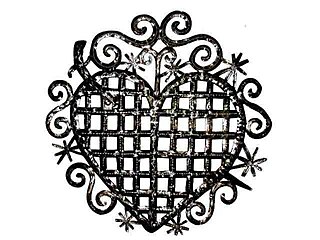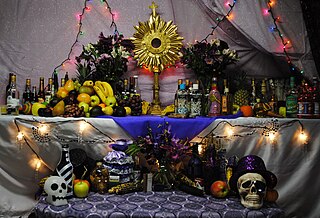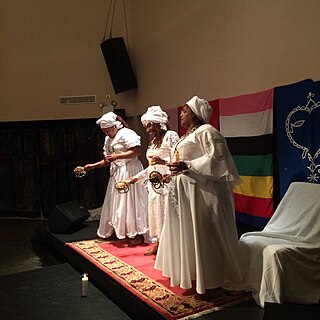Related Research Articles

Damballa, also spelled Damballah, Dambala, Dambalah, among other variations, is one of the most important of all loa, spirits in Haitian Voodoo, Louisiana Voodoo and other African diaspora religious traditions such as Obeah. He is traditionally portrayed as a great white serpent, originating in the city of Wedo in modern-day Benin. Damballa is said to be the Sky Father and the primordial creator of all life, or the first thing created by Gran Met. In those Vodou societies that view Damballa as the primordial creator, he created the cosmos by using his 7,000 coils to form the stars and the planets in the heavens and to shape the hills and valleys on earth. In others, being the first thing created by God, creation was undertaken through him. By shedding the serpent skin, Damballa created all the waters on the earth. As a serpent, he moves between land and water, generating life, and through the earth, uniting the land with the waters below. Damballa is usually syncretized with either Saint Patrick or Moses. He is counted among the Rada loa.

Ayizan is the loa of the marketplace and commerce in Vodou, especially in Haiti.
Azaka-Tonnerre is a loa of thunder in Vodou, especially in Haiti. He is in the same "family" as Azaka Medeh, the loa of harvest.

Maman Brigitte sometimes also written as Manman Brigitte and also known by Gran Brigitte, Grann Brigitte, Manman, Manman Brigit, and Maman Brijit is a death loa and the consort of Baron Samedi in Haitian Vodou. She drinks rum infused with hot peppers and is symbolized by a black rooster. Maman Brigitte protects graves in Haitian cemeteries that are marked by the cross of Baron Samedi. Graves that are protected by Brigitte are marked by a mound of stones. Like Samedi and the Guede, she is foul-mouthed. She is also the adoptive mother of Guede Nibo.
Kalfu is one of the petro aspects of Papa Legba, a lwa in Haitian Vodou. He is often envisioned as a young man or as a demon; his color is red and he favors rum infused with gunpowder. He is often syncretized with Satan.

Simbi is a large and diverse family of serpents also known as loa in Haitian Vodou. Some names for the Simbi loa include Simbi Dlo, Simbi Makaya, Simbi Andezo, and Gran Simba. Traditionally in their Kongo context, they are all associated with water, but in the Haitian Vodoun context they have wide-ranging associations. For example, Simbi Makaya is a great sorcerer and served in particular in the Sanpwel secret societies. Simbi Anpaka is a loa of plants, leaves, and poisons.

Ezilí Dantor or Erzulie Dantó is the main loa or senior spirit of the Petro family in Haitian Vodou.
Haitian Vodou is a syncretic mixture of Roman Catholic rituals developed during the French colonial period, based on traditional African beliefs, with roots in Dahomey, Kongo and Yoruba traditions, and folkloric influence from the indigenous Taino peoples of Haiti. The Loa, or spirits with whom Vodouisants work and practice, are not gods but servants of the Supreme Creator Bondye. In keeping with the French-Catholic influence of the faith, vodousaints are for the most part monotheists, believing that the Loa are great and powerful forces in the world with whom humans interact and vice versa, resulting in a symbiotic relationship intended to bring both humans and the Loa back to Bondye. "Vodou is a religious practice, a faith that points toward an intimate knowledge of God, and offers its practitioners a means to come into communion with the Divine, through an ever evolving paradigm of dance, song and prayers."

Chukwu is the supreme being of Igbo spirituality. In the Igbo pantheon, Chukwu is the source of all other Igbo deities and is responsible for assigning them their different tasks. The Igbo people believe that all things come from Chukwu, who brings the rain necessary for plants to grow and controls everything on Earth and the spiritual world. They believe Chukwu to be an undefinable omnipotent and omnipresent supreme deity that encompasses everything in space and space itself.

A veve is a religious symbol commonly used in different branches of Vodun throughout the African diaspora, such as Haitian Vodou and Louisiana Voodoo. The veve acts as a "beacon" for the loa, and will serve as a loa's representation during rituals.

Homosexuality in Haitian Vodou is religiously acceptable and homosexuals are allowed to participate in all religious activities. However, in countries with large Vodou populations, some Christian influence may have given homosexuality a social stigma, at least on some levels of society.
Azaka is the loa of the harvest in Haitian Vodou mythology.
A bokor or caplata (female) is a Vodou witch for hire who is said to serve the loa "with both hands", practicing for both good and evil. Their practice includes the creation of zombies and of 'ouangas', talismans that house spirits.

A manbo is a priestess in the Haitian Vodou religion. Haitian Vodou's conceptions of priesthood stem from the religious traditions of enslaved people from Dahomey, in what is today Benin. For instance, the term manbo derives from the Fon word nanbo. Like their West African counterparts, Haitian manbos are female leaders in Vodou temples who perform healing work and guide others during complex rituals. This form of female leadership is prevalent in urban centers such as Port-au-Prince. Typically, there is no hierarchy among manbos and oungans. These priestesses and priests serve as the heads of autonomous religious groups and exert their authority over the devotees or spiritual servants in their hounfo (temples).

Arusi are spirits that are worshiped and served in the Igbo religion. There are many different Arusi and each has its own purpose and function.

The Igbo, whose traditional territory is called the Bight of Biafra, became one of the principal ethnic groups to be enslaved during the Trans-Atlantic Slave Trade. An estimated 14.6% of all slaves were taken from the Bight of Biafra between 1650 and 1900. The Bight’s major slave trading ports were located in Bonny and Calabar. The majority of Igbo slaves were kidnapped during village raids. The journey for Igbo slaves often began in the ancient Cave Temple that was located in Arochukwu Kingdom. During this period, the three Igbo Kingdoms followed the same culture and religion, yet tended to operate very differently from each other. The Kingdom of Nri and the Independent Igbo States did not practice slavery, and slaves from neighbouring lands would often flee to these kingdoms in order to be set free. Arochukwu, on the other hand, practiced a system of indentured servitude that was remarkably different from chattel slavery in the Americas. Eventually, with Europeans beginning to encroach on Igbo territory, causing the kingdoms to desire weaponry to defend themselves. In order to obtain European goods and weaponry, Arochukwu began to raid villages of the other Igbo kingdoms - primarily those located in the Igbo hinterlands. People would be captured, regardless of gender, social status, or age. Slaves could have been originally farmers, nobility, or even people who had committed petty crimes. These captured slaves would be taken and sold to European slave traders on the coast. Another way people were enslaved was through the divine oracle who resided in the Cave Temple complex. All Igbos practiced divination called Afa, but the Kingdom of Arochukwu was different because it was headed by a divine oracle who was in charge of making decisions for the king. During this time, if someone committed a crime, was in debt, or did something considered an "abomination", they would be taken to the cave complex to face the oracle for sentencing. The oracle, who was also influenced by the demands of European slave traders, would sentence these people to slavery, even for small crimes. The victim would be commanded to walk further into the cave so that the spirits could "devour" them, but, in reality, they were taken to an opening on the other side and loaded directly onto a waiting boat. This boat would take them to a slave ship en route to the Americas.
A hounfour is a Vodou temple. The leader of the ceremony is a male priest called a houngan, or a female priest called a mambo. The term is believed to derive from the Fon houn for, "abode of spirits."
Afro-Haitians are Haitians who trace their full or partial ancestry to Sub-Saharan Africa. They form the largest racial group in Haiti and together with other Afro-Caribbean groups, the largest racial group in the region.

Dominican Vudú, also known as Las 21 Divisiones, is a syncretic religion of Caribbean origin which developed on the island of Hispaniola.

Tchaka or Chaka is a Haitian stew made from hominy, beans, pumpkin (joumou), and meat. It is used as an offering to the loa in Haitian Vodou. The nutritious soup is also associated with festivities and family time.
References
- ↑ Bach, Marcus (1952). Strange altars. Bobbs-Merrill.
- ↑ Lovejoy, Paul E. (2000). Identity in the Shadow of Slavery. Top: Continuum International Publishing Group. p. 59. ISBN 0-8264-4725-2.
- ↑ Courlander, Harold (1939). Haiti singing. The University of North Carolina press.